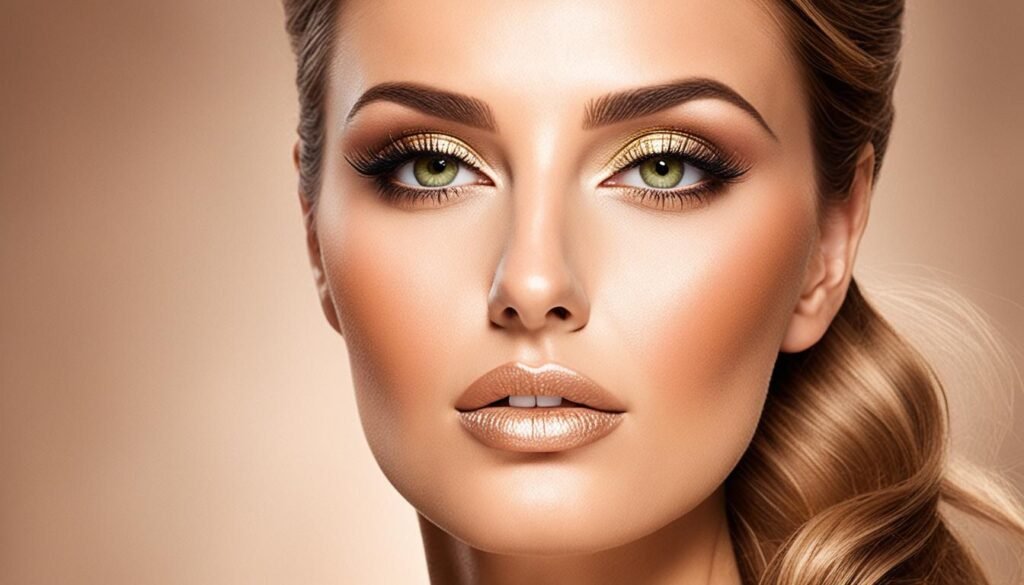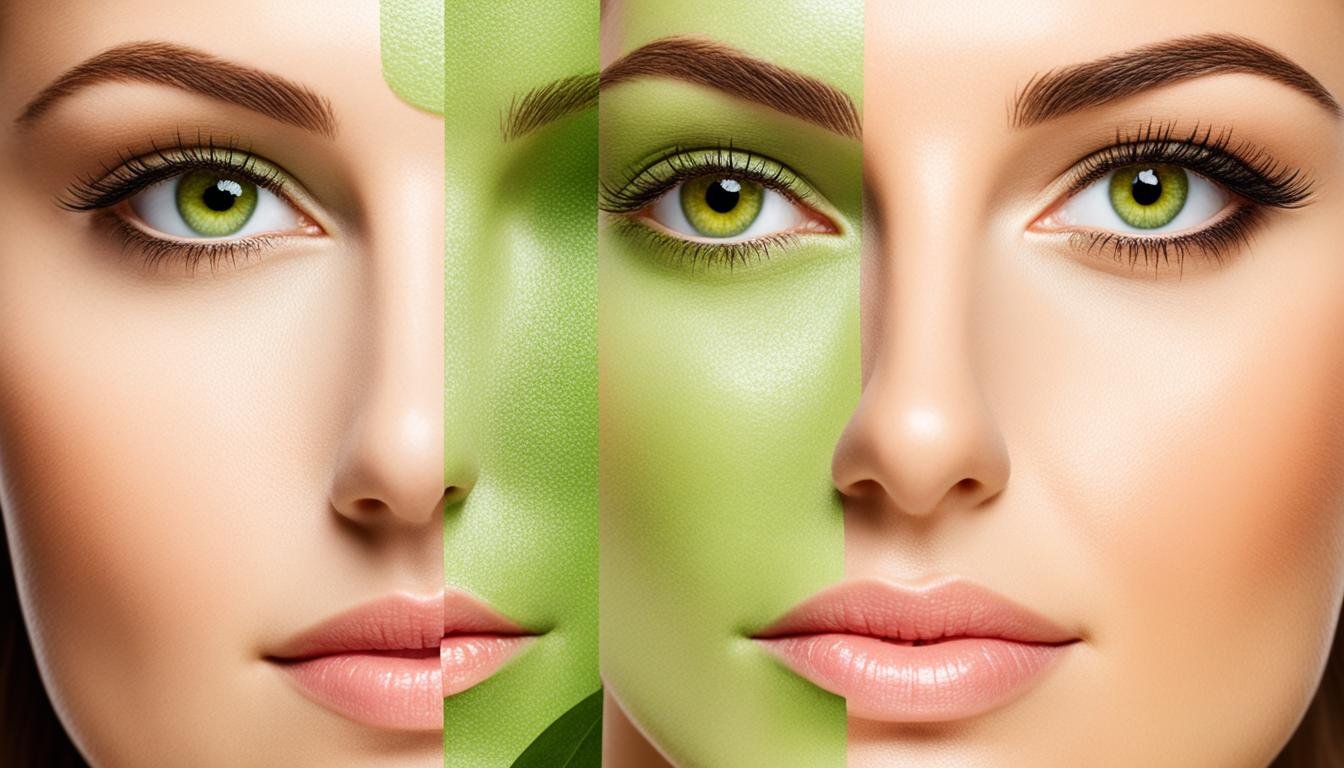What does olive skin look like?
Have you ever wondered what defines olive skin? Is it a particular shade or a combination of undertones? Olive skin, with its unique pigmentation, has captured the attention of many. But what does it really look like?
Olive skin refers to a range of skin tones with moderate or lighter tan or brownish colors, often described as having tan, brown, cream, greenish, yellowish, or golden undertones. It falls within the Type III to Type IV and Type V categories on the Fitzpatrick scale, which measures pigmentation levels in human skin. But what does that mean in terms of appearance?
Olive skin can vary in pigmentation, from cream or dark cream to darker olive or light brown for Type III, brownish or darker olive to moderate brown for Type IV, and olive to dark tan for Type V. It is important to note that olive skin can have different hair and eye colors and can be found in various ethnicities and nationalities.
Key Takeaways:
- Olive skin encompasses a range of tan or brownish colors with undertones such as tan, brown, cream, greenish, yellowish, or golden.
- Olive skin falls within the Type III, Type IV, and Type V categories on the Fitzpatrick scale.
- Olive skin can have different hair and eye colors and can be found in various ethnicities and nationalities.
How to Determine If You Have Olive Skin
To determine if you have olive skin, you can look at your undertones. Check the veins on your wrist; if they appear blue or pink, you likely have cool undertones. If the veins look greenish or if you have a hard time discerning a distinct color, you may have warm undertones. If your skin complements both silver and gold jewelry and looks good in both bright white and off-white clothing, you likely have neutral undertones. Olive skin can have cool, warm, or neutral undertones, so it is essential to consider the overall appearance of your skin rather than just the undertones. Additionally, olive skin is not limited to tan shades; it can also include pale olive skin, which has a champagne or pale gold appearance.
| Undertones | Vein Colors | Jewelry Complements |
|---|---|---|
| Cool Undertones | Blue or Pink | Silver and Gold |
| Warm Undertones | Greenish or Indistinct Color | Gold |
| Neutral Undertones | Varies or Indistinct Color | Silver and Gold |
Makeup Tips for Olive Skin
Finding the right makeup shades for olive skin can be a challenge. With its unique undertones and versatility, olive skin requires careful consideration when selecting foundation, blush, eye makeup, lip color, and even hair color. Let us guide you through some expert tips to enhance your natural beauty.
Foundation
When it comes to foundation, it’s crucial to choose a shade that complements your olive skin’s undertones. Look for foundations with neutral tones but a hint of green, as this can help balance the natural pigmentation. For those with darker olive skin tones, opting for foundations with a gold or amber base can create a seamless match. To combat any dullness or sallow appearance, consider using a foundation that has a built-in luminizer to achieve a radiant glow.
Blush
Enhancing the natural flush of olive skin can be achieved with the right blush shade. Peach-based tones such as salmon or pinks with gold undertones can beautifully complement olive skin, providing a fresh and healthy glow. Experimenting with different blush shades can help you discover which hues bring out the best in your complexion.
Eye Makeup
The eyes are a focal point of any makeup look, and for olive skin, certain shades can truly enhance their beauty. Jewel tones like emerald, amethyst, and sapphire can make your eyes pop, while earth tones like bronze and terracotta can create a warm and sultry look. Shades with gold and amber highlights can also accentuate the warmth of olive skin, adding depth and dimension to your eye makeup.
Lip Color
Choosing the right lip color for olive skin involves considering your undertones. If you have warm undertones, opting for reds with a deeper, plum or raisin base can be flattering. Those with cool undertones might find that vibrant, blue-toned reds suit them better. Experimenting with shades like rich berries, elegant nudes, or even bold oranges can help you find your signature lip color that complements your olive skin tone.
Hair Color
Your hair color plays a significant role in how makeup shades appear on your olive skin. For a harmonious and balanced look, consider your hair color when selecting makeup shades. A general rule of thumb is to select makeup colors that are in the same color family as your hair. For example, if you have warm, honey-toned highlights, complementary warm-toned makeup shades can create a cohesive and stunning look.
Remember, makeup is an art form, and with olive skin, there are endless possibilities to explore. Take the time to experiment with different shades, finishes, and techniques to find what works best for you. Embrace your unique beauty and celebrate the versatility of your olive skin.

| Makeup Product | Recommended Shades for Olive Skin |
|---|---|
| Foundation | Neutral tones with a hint of green or foundations with a gold or amber base |
| Blush | Peach-based shades, salmon or pinks with gold undertones |
| Eye Makeup | Jewel tones, earth tones, shades with gold and amber highlights |
| Lip Color | Reds with a deeper, plum or raisin base, colors that complement undertones |
| Hair Color | Consider hair color when choosing makeup shades for a cohesive look |
Conclusion
Olive skin is a unique and versatile skin tone that possesses a wide range of beautiful colors and undertones. Whether you have pale olive skin or deep olive skin, it is crucial to recognize and embrace the inherent beauty that comes with this versatile complexion. The warm undertones of olive skin lend it the ability to adapt to various makeup shades and styles, allowing you to effortlessly enhance your natural features.
Understanding your undertones and selecting makeup products with similar tones can help you achieve a natural and flattering look that enhances your olive skin’s unique beauty. Whether it’s choosing a foundation with a green undertone, opting for blush and eye makeup shades with warm undertones, or selecting lip colors that complement your skin’s undertones, embracing your olive skin’s versatility is key to creating a harmonious and flawless appearance.
Olive skin is not exclusive to any specific ethnicity or nationality but is found across diverse populations. Its presence across different cultures and backgrounds is a testament to its universal appeal and allure. By recognizing and celebrating the distinctive qualities of olive skin, we can collectively embrace and appreciate its unmatched beauty.
In conclusion, olive skin is a remarkable and adaptable skin tone that deserves recognition and appreciation. Its uniqueness lies in its ability to effortlessly adapt to different makeup shades, allowing individuals with olive skin to showcase their natural beauty. So, let us embrace the beauty of olive skin, recognize its versatile nature, and celebrate its unmistakable charm.






